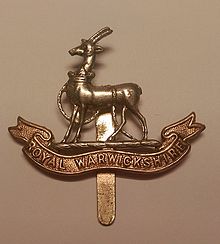The Royal Warwickshire Regiment
| 6th Regiment of Foot 6th (1st Warwickshire) Regiment of Foot 6th (Royal First Warwickshire) Regiment of Foot Royal Warwickshire Regiment Royal Warwickshire Fusiliers |
|
|---|---|

Royal Warwickshire Regiment Cap Badge
|
|
| Active | 1685–1968 |
| Country |
|
| Branch |
|
| Type | Infantry |
| Role | Line infantry |
| Size |
1-4 Regular battalions |
| Garrison/HQ | Budbrooke Barracks, Warwickshire |
| March |
Quick: The British Grenadiers, Warwickshire Lads |
| Mascot(s) | Indian black buck antelope, 'Bobby' |
1-4 Regular battalions
Up to 2 Militia battalions
Up to 4 Territorial and Volunteer battalions
Quick: The British Grenadiers, Warwickshire Lads
The Royal Warwickshire Regiment, previously titled the 6th Regiment of Foot, was a line infantry regiment of the British Army in continuous existence for 283 years. The regiment saw service in many conflicts and wars, including the Second Boer War and both the First and Second World Wars. On 1 May 1963 the regiment was re-titled, for the final time, as the Royal Warwickshire Fusiliers and became part of the Fusilier Brigade.
In 1968, by now reduced to a single Regular battalion, the regiment was amalgamated with the other regiments in the Fusilier Brigade – the Royal Northumberland Fusiliers, the Royal Fusiliers (City of London Regiment) and the Lancashire Fusiliers – into a new large infantry regiment, to be known as the Royal Regiment of Fusiliers, becoming the 2nd Battalion of the new regiment.
The regiment traces its origins to the 17th century. In the Netherlands in 1674 the government retained two regiments of English troops, two of Scots and one Irish. In 1685 when James II requested their services during the Duke of Monmouth's rebellion and organised them into two units, given the precedence as the 5th and 6th Regiments of Foot.
...
Wikipedia
